Further Voices of Lombard Street: Lazinsky’s Fish Market

A blog post by Director of Collections and Exhibits Joanna Church. To read more posts by Joanna click HERE.
Sometimes, the biggest difficulty in opening an exhibit is that once it’s finished, it’s finished. Unless the exhibit was specifically designed for future expansion, adding new stories or artifacts can be challenging and impractical. But one of the best things about exhibits – from a collections staff point of view, anyway – is the way they encourage visitors to think about their own family history, and perhaps offer to share that information and material with the museum.
Such is the case with Voices of Lombard Street. For example, over the past few years, several descendants of the Lazinsky family have pointed out, rightfully, that there’s a story that’s missing from the exhibit: that of the Lombard Street fish markets, specifically their own, Lazinsky’s. They’ve given us two wonderful artifacts from the store, in the hopes that these pieces will help us broaden the stories we tell about the Lombard Street culture and economy. These two pieces are not in the exhibit – there’s just no easy way to add them to an already stuffed-to-the-gills (if you’ll pardon a fish pun) gallery – but thanks to the magic of the internet, we can share them virtually with our visitors.
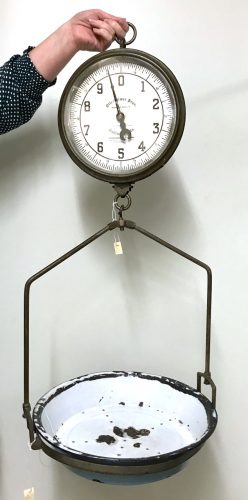
This hanging scale was used at Lazinsky’s Fish Market, Lombard Street, owned by Morris Lazinsky (1867-1940). The 1910 census shows Morris Lazinsky on E. Lombard Street, operator of a “fish business.” A scale is a vital part of a meat or fish store – this is as true today in a Whole Foods or Safeway as it was 110 years ago. This would have been a crucial piece of equipment in the Lazinsky’s business.
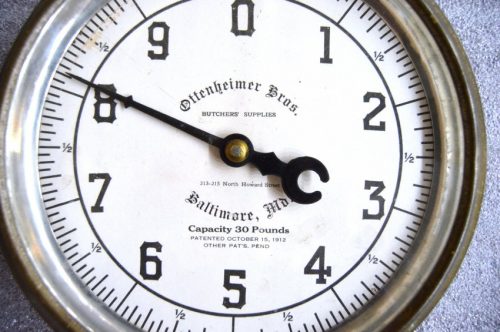
The scale went to one of Morris and Sara Lazinsky’s daughters (either Helen or Rose) after the market closed in the late 1930s. When she died, the donor – her niece, and granddaughter of Morris and Sara – acquired it. It was in her house for many years, in the dining room and later the kitchen, usually with flowers in it. Although it was no longer being used for its original purpose, it was still an important family piece, part of a treasured history.
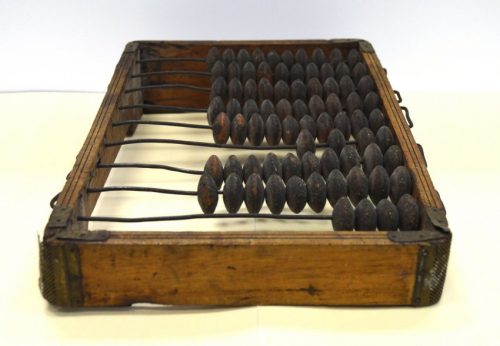
This well-worn and much-used abacus – designed to lay flat on a tabletop, with the work surface of strung beads on a slight angle for the ease of the user – was part of the accounting equipment at Lazinsky’s. It was brought to the US in the early 1900s by the Lazinsky family, who had used it in their general store in their home town in Russia. They continued to use it in their fish market on Lombard Street, perhaps in addition to a modern cash register, which makes sense; in a family-run business, if some of the older family members were more comfortable with the abacus, why not keep using it?
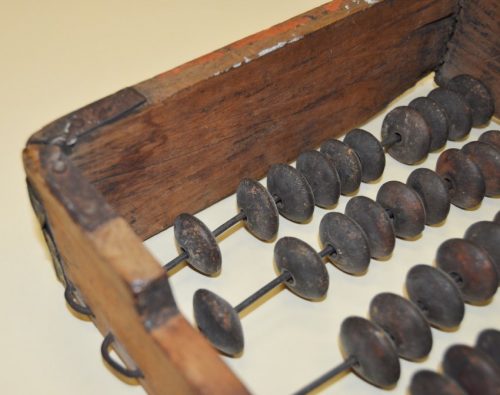
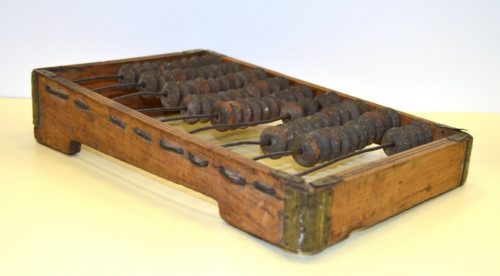
The donor did some research for us before bringing this unusual piece to us. He reports:
“This particular abacus has 9 rows. The bottom and the 4th from the bottom have 4 beads, and the rest have 10 beads. From the top, each bead in the top row represents 10000 rubles. The next row down would have 1000-ruble beads, then 100, 10, 1, quarter ruble (=25 kopek), 10 kopeks, 1 kopek, and in the bottom row each bead was a quarter kopek, which was seems to have been the smallest unit of currency they ever had. It was brought over from Russia & is pre 1900. The US halfpenny was discontinued in 1857, so I would guess that they never used the bottom row in this country. Rows 2 & 3 from the bottom could have been used for pennies and dimes, the next row for quarters, and up the line to dollars, tens, 100s, 1000s and 10000s. I would assume that the upper rows did not get a lot of use in a neighborhood fish store.”
The family does not – at least as far as anyone has yet discovered – have any photos of the market, whether inside or the exterior, and I’ve not been able to definitely find the market in any street views in our or other museum collections. However, we do have some memories to share from another source. In 1982, Helen Sollins interviewed her mother-in-law, Kathryn Rodbell Sollins (1901-1995), about her memories of Lombard Street. In the interview, Mrs. Sollins claimed to be able to remember as far back as September 1905 (earlier than could Seymour Attman, apparently, who had recently been interviewed by Helen; this seems to have been a point of pride). She grew up on East Lombard Street with her parents, Solomon and Fannie Rodbell, and her siblings, and was part of the busy life and culture along the street.
She recalled the Lazinskys and their market clearly, telling her daughter-in-law that the family started out as peddlers on the street with fish in a basket, eventually renting a first-floor flat on Lombard. This isn’t a direct quotation – we’ve not fully transcribed the interview – but the typed index summarizes the early version of the market like this:
“Thursday morning, they [the Lazinskys] would empty the front room (the bedroom), move all the furniture into the other room, and put out their fish tables and wares. Thursday night they’d all crowd into the back room. Friday morning they’d sell the rest of the fish, then clean it all up and move back in until the following Thursday.”
Mrs. Sollins was friends with the Lazinsky daughters, Helen, Lena, and Rose, and spent a lot of time with the family since she didn’t have sisters her own age. She remembered that after the family had a more proper storefront, Morris (or Mendel, as she called him) Lazinsky’s brother opened another market across the street from Morris’s – Morris’s descendants confirmed this – and that both of these fish markets, in Mrs. Sollins’ words, catered to a “very, very fine” clientele.
And there you have yet another Voice to add to the Lombard Street story. What memories of shopping or living on Lombard do you have to share?
